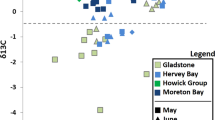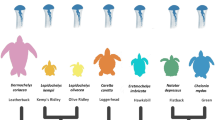Summary
We measured the bones of extinct great auks Pinguinis impennis that were killed during recent centuries on Funk Island off the northeast coast of Newfoundland. Comparisons of these measurements with those taken elsewhere suggest that great auks from Funk Island, which is situated in a Low Arctic oceanographic region, were larger than conspecifics from Boreal oceanographic regions. This finding is supported by extant alcid species that inhabit Boreal, Low Arctic or Boreal through High Arctic ocean regions and tend to increase in body size with increasing latitude (generally decreasing sea surface temperature). We suggest that paleoecological sea surface temperatures and food webs may have favored oceanographic-related variation in body sizes of great auks. The variances of the bone sizes of great auks from Funk Island were not less than those of a sample of great auk bones collected from Scandinavian archaeological sites that cover an extensive geographic range and that span seven millenia. This finding is inconsistent with a previously suggested latitudinal cline in body size among great auks in Scandinavia. Research techniques and studies that could address questions of great auk feeding ecology and population genetics are considered.
Similar content being viewed by others
References
Ashmole NP (1971) Sea bird ecology and the marine environment. In: Farner DS, King JR (eds) Avian biology, vol 1. Academic, New York, pp 223–286
Ascenzi A, Segré A (1971) The formation containing a Neanderthal mandible at Archi Reggio Calabria. Atti Accad Naz Lincei Rend CI Sci Fie Mat Sez 111, 50:763–771
Barrett RT, Peterz M, Furness RW, Durinck J (1989) The variability of biometric measurements. Ring Migr 10:13–16
Bédard J (1985) Evolution and characteristics of the Atlantic Alcidae. In: Nettleship DN, Birkhead TR (eds) The atlantic alcidae. Academic, Orlando, pp 1–51
Bengtson S-A (1984) Breeding ecology and extinction of the great auk (Pinguinus impennis): anecdotal evidence and conjectures. Auk 101:1–12
Birt-Friesen VL, Montevecchi WA, Gaston AJ, Davidson WS (1991) Direct sequence analysis of amplified DNA of the North Atlantic population of thick-billed murres Uria lomvia. Evolution (in press)
Bradstreet MSW, Brown RGB (1985) Feeding ecology in the Atlantic Alcidae. In: Nettleship DN, Birkhead TR (eds) The atlantic alcidae. Academic, Orlando, pp 263–318
Brodkorb P (1960) Great auk and common murre from a Florida midden. Auk 77:342–343
Brown RGB (1985) The Atlantic Alcidae at sea. In: Nettleship DN, Birkhead TR (eds) The atlantic alcidae. Academic, Orlando, pp 384–426
Dunbar MJ (1968) Ecological development in polar regions. Prentice-Hall, Englewood Cliffs, New Jersey, p 119
Fisher J, Lockley RM (1954) Sea-birds. Collins, London, p 320
Fradkin A (1980) Bird remains from two South Florida prehistoric sites. Fla Sci 43:111–115
Freuchen P, Salomonsen F (1958) The arctic year. Putnam's, New York, p 438
Gales RP, Green B (1990) The annual energetics cycles of little penguins (Eudypula minor). Ecology 71:2297–2312
Garrad LS (1971) Bird remains, including those of a great auk Alca impennis, from a midden deposit in a cave at Perwick Bay, Isle of Man. Ibis Ecology 114:258–259
Gaston AJ, Chapdelaine G, Noble DG (1984) Phenotypic variation among thick-billed murres from colonies in Hudson Strait. Arctic 37:284–287
Greenway JC Jr. (1967) Extinct and vanishing birds of the world. Dover, New York, p 520
Harris MP (1978) Supplementary feeding of young puffins, Fratercula arctica. J Anim Ecol 47:15–23
Harris MP (1984) The puffin. Poyser, Carlton, p 224
Harris MP (1985) Morphology and breeding of puffins at Isle of May and St. Kilda, Scotland. Biol Conserv 32:81–97
Harris MP, Birkhead TR (1985) Breeding ecology of the Atlantic Alcidae. In: Nettleship DN, Birkhead TR (eds) The atlantic alcidae. Academic, Orlando, pp 156–204
Hay OP (1902) On the finding of the bones of the great auk (Plautus impennis) in Florida. Auk 19:255–258
Hobson KA, Montevecchi WA (1991) Stable isotopic determination of the trophic status of the great auk. Oecologia (in press)
Hufthammer A-K (1982) Geirfuglens utbredelse og morfologiske variajon i Skandinavia. Unpubl thesis. Universitetet i Bergen, Bergen, Norway, p 60
Jordan RM, Olson SL (1982) First record of the great auk (Penguinis impennis) from Labrador. Auk 99:167–168
Lahtipera P (1979) An osteological comparison of recent and subfossil puffins Fratercula arctica L from Northern Norway. Archaeozoology 1:262–267
Livezey BC (1988) Morphometrics of fightlessness in the Alcidae. Auk 105:681–698
Lucas FA (1888) The expedition to Funk Island with observations upon the history and anatomy of the great auk. US Nat Mus Rep:493–529
Mayr E (1956) Geographical character gradients and climatic adaptation. Evolution 10:105–108
Mayr E (1963) Animal species and evolution. Harvard University, Cambridge Massachusetts, p 797
Meldgaard M (1988) The great auk, Pinguinus impennis (L.) in Greenland. Hist Biol 1:145–178
Montevecchi WA, Barrett RT (1987) Prey selection by gannets at breeding colonies in Norway. Ornis Scand 18:319–322
Montevecchi WA, Tuck LM (1987) Newfoundland birds: exploitation, study, conservation. Nuttall Ornithological Club, Cambridge, Massashusetts. p 273
Montevecchi WA, Birt-Friesen VL, Cairns DK (1991) Reproductive energetics and prey harvest of Leach's strom-petrels in the northwest Atlantic. Ecology (in press)
Nettleship DN, Birkhead TR (eds) (1985) The atlantic alcidae. Academic, Orlando, p 574
Nettleship DN, Evans PGH (1985) Distribution and status of the Atlantic Alcidae. In: Nettleship DN, Birkhead TR (eds) The atlantic alcidae. Academic, Orlando, pp 53–154
Peterson A (1976) Size variables in puffins, Fratercula arctica, from Iceland and bill features as criteria of age. Ornis Scand 7:185–192
Salomonsen F (1967) The seabirds of Greenland. (R.G.B. Brown Transl). Canadian Wildlife Service, Dartmouth, Nova Scotia
Salomonsen F (1972) Zoogeographical and ecological problems in arctic birds. Proc Internat Ornithol Congr 15:25–77
Storer RW (1952) A comparison of variation, behavior and evolution in the seabird genera Uria and Cepphus. Univ Calif Publ Zool 52:121–222
Tuck LM (1961) The murres: their distribution, populations and biology. Canadian Wildlife Monograph Series (No.1), Ottawa, p 260
Vaurie C (1965) The birds of the Palaearctic fauna: non-passeriformes. Witherby, London, p 763
Weigel PH (1958) Great auk remains from a Florida shell midden. Auk 75:215–216
Author information
Authors and Affiliations
Rights and permissions
About this article
Cite this article
Burness, G.P., Montevecchi, W.A. Oceanographic-related variation in the bone sizes of extinct great auks. Polar Biol 11, 545–551 (1992). https://doi.org/10.1007/BF00237947
Received:
Accepted:
Issue Date:
DOI: https://doi.org/10.1007/BF00237947




